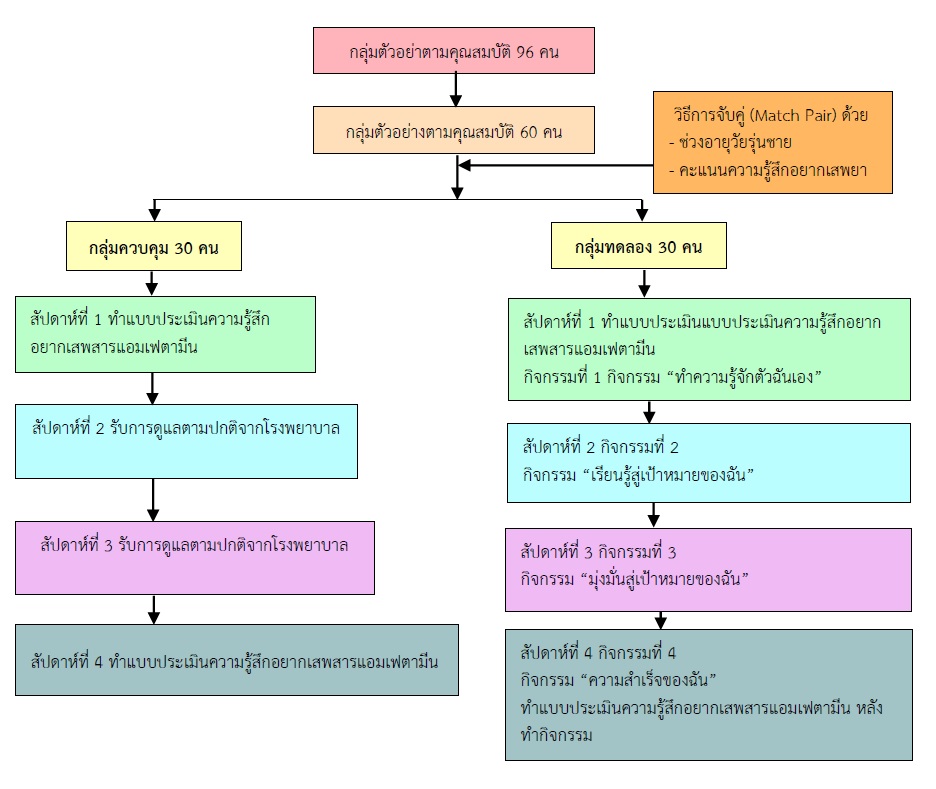ผลของโปรแกรมการพยาบาลตามทฤษฎีการบรรลุเป้าหมายของคิงร่วมกับ การใช้ดนตรีต่อความอยากเสพของวัยรุ่นชายที่เสพติดสารแอมเฟตามีน
คำสำคัญ:
โปรแกรมการพยาบาลตามทฤษฎีการบรรลุเป้าหมายของคิงร่วมกับการใช้ดนตรี, ความอยากเสพสารแอมเฟตามีน, วัยรุ่นชายที่เสพติดสารแอมเฟตามีนบทคัดย่อ
การวิจัยกึ่งทดลองนี้แบบสองกลุ่มวัดก่อนและหลังการทดลอง มีวัตถุประสงค์เพื่อศึกษาผลของโปรแกรมการพยาบาลตามทฤษฎีการบรรลุเป้าหมายของคิงร่วมกับการใช้ดนตรีต่อความอยากเสพสารแอมเฟตามีน กลุ่มตัวอย่างเป็นผู้เสพติดสารแอมเฟตามีน เพศชาย อายุ 18-21 ปี ที่ได้รับการวินิจฉัยตามเกณฑ์การวินิจฉัย ICD-10 ที่เข้ารับการบำบัดรักษาแผนกผู้ป่วยนอกโรงพยาบาลจิตเวชแห่งหนึ่งในภาคใต้ จำนวน 60 คน แบ่งกลุ่มทดลองและกลุ่มควบคุม ด้วยการจับคู่กลุ่มตัวอย่างด้านอายุกับคะแนนความอยากเสพสารแอมเฟตามีน กลุ่มละ 30 คน เครื่องมือวิจัยประกอบด้วย 1) โปรแกรมการพยาบาลตามทฤษฎีการบรรลุเป้าหมายของคิงร่วมกับการใช้ดนตรี เป็นกิจกรรมรายบุคคล จำนวน 4 กิจกรรม ๆ ละ 45-60 นาที สัปดาห์ละ 1 ครั้งเป็นเวลา 4 สัปดาห์ 2) แบบสอบถามข้อมูลทั่วไป และ 3) แบบประเมินความรู้สึกอยากเสพสารแอมเฟตามีน โดยเครื่องมือทั้ง 3 ส่วนผ่านการตรวจสอบตรงเชิงเนื้อหาด้วยผู้ทรงคุณวุฒิ 3 คน ค่าความเที่ยงของแบบประเมินความรู้สึกอยากเสพสารแอมเฟตามีน เท่ากับ .89 วิเคราะห์ข้อมูลโดยใช้สถิติพรรณนา Chi-Square, Wilcoxon Signed-Ranks Test, Mann-Whitney Test และ Independent t-Test ผลการวิจัย พบว่า
1) คะแนนมัธยฐานของความรู้สึกอยากเสพสารแอมเฟตามีนของวัยรุ่นที่เสพติดสารแอมเฟตามีน หลังได้รับโปรแกรมการพยาบาลตามทฤษฎีการบรรลุเป้าหมายของคิงร่วมกับการใช้ดนตรีต่ำกว่าหลังได้รับโปรแกรมอย่างมีนัยสำคัญทางสถิติ (z=-4.78, p<.001) และ 2) คะแนนมัธยฐานของความรู้สึกอยากเสพสารแอมเฟตามีนของวัยรุ่นเสพติดสารแอมเฟตามีนกลุ่มทดลอง หลังได้รับโปรแกรมการพยาบาลตามทฤษฎีการบรรลุเป้าหมายของคิงร่วมกับการใช้ดนตรีต่ำกว่ากลุ่มควบคุมที่ได้รับการดูแลตามปกติอย่างมีนัยสำคัญทางสถิติ (z=-6.74, p<001)
โปรแกรมการพยาบาลตามทฤษฎีการบรรลุเป้าหมายของคิงร่วมกับการใช้ดนตรีของวัยรุ่นที่เสพติดสารแอมเฟตามีน สามารถลดความรู้สึกอยากเสพสารแอมเฟตามีนได้ ดังนั้นพยาบาลควรนำโปรแกรมนี้ไปใช้ในคลินิกผู้ป่วยนอกของโรงพยาบาล
เอกสารอ้างอิง
American Music Therapy Association. (2010). About Music Therapy & AMTA. Retrieved May 15, 2019 from http://www.musictherapy.org/about/quotes.
Blood, A. J. (2001). Intensely Pleasurable Responses to Music Correlate with Activity in the Brain Regions Implicated in Reward and Emotion. Proceedings of the National. Academy of Sciences, 98(11), 818-823.
Blum, K. (2010). Do Dopaminergic Gene Polymorphisms Affect Mesolimbic Reward Activation of Music Listening Response Therapeutic Impact on Reward Deficiency Syndrome (RDS). Medical Hypotheses, 74(3), 513-520.
Boromarajonani National Institute for Drug Addiction Treatment and Rehabilitation. (2019). Treatment Information Drug Patients of the Boromarajonani National Institute of Drug Addiction Treatment and Rehabilitation. Statistical data. Retrieved May 15, 2019 from http://www.pmnidat.go.th/thai/index.php?option=com_content&task=category§ionid=2&id=9&Itemid=51.
Carolyn, J. M., & Patricia, A. H. (2009). The Theory of Music, Mood and Movement to Improve Health Outcomes. Journal of Advanced Nursing, 65(10), 2249-2257.
Cevasco, A. M., Kennedy, R., & Generally, N. R. (2005). Comparison of Movement-to-Music, Rhythm Activities, and Competitive Games on Depression, Stress, Anxiety, and Anger of Females in Substance Abuse Rehabilitation. Journal of Music Therapy, 43(1), 64-80.
Chaiudomsuk, K., Paholpak, P., Vadhanavikkit, P., & Aphisitphinyo, S. (2017). Psychiatry. Khon Kaen. Klungnana Printing Press. (in Thai).
Changchana, W. (2020). Music Therapy: Calmness of Meditation Towards Unlimited Imagination. Bansomdej Music Journal, 2(1), 119-134.
Choombuathong, A., Yimnoi, C., & Samma, C. (2017). Music Therapy. Huachiew Chalermprakiet Science and Technology Journal, 3(2), 77-87.
Department of Mental Health. (2019). Results of a Survey of Information on Cultural Situation Statistics of Thai Children and Youth. Mental Health Articles. Retrieved June 21, 2019 from https://www.dmh.go.th/news-dmh/view.asp?id=28478
Ghetti, C., Chen, X. J., Brenner, A. K., Hakvoort, L. G., Lien, L., Fachner, L., et al. (2022). Music Therapy for People with Substance Use Disorder (Review). Cochrane Database of Systematic Review, 5(4). DOI: 10.1002/14651858.CD012576.pub3.
Kalayasiri, R. (2018). Addiction & Psychiatric Complications. Bangkok: Chulalongkorn University.
King, I. M. (1981). A Theory for Nursing: Systems, Concept, Process. New York: A Wiley Medical Publication.
Koelsch, S. (2015). Music-Evoked Emotions: Principles, Brain Correlates and Implications for Therapy. Annals of the New York Academy of Sciences, 1337, 193–201.
Koob, G. F., & Volkow, N. D. (2016). Neurobiology of Addiction: A Neurocircuitry Analysis. Lancet Psychiatry, 3(8), 760-773
Ministry of Public Health. (2018). Community Based Treatment and Care. Samut Sakhon: Born To Be Publishing. (In Thai)
Moore, S. K. (2013). A Systematic Review on the Neural Effects of Music on Emotion Regulation: Implications for Music Therapy Practice. Journal of Music Therapy, 50(3), 198–242.
Pattrakorn, A., & Chaipichitpan, C. (2015). The Effect of FAST Model for Addition Patients in Thanyarak Institute. Journal Psychiatric Association Thailand, 60(1), 71-81.
Raabe, A., Grusser, S. M., Wessa, M., Podschus, J., & Flor, H. (2005). The Assessment of Craving: Psychometric Properties, Factor Structure and a Revised Version of the Alcohol Craving Questionnaire (ACQ). Addiction, 100, 227-234.
Redish, A. D. (2004). Addiction as a Computational Process Gone Awry. Science, 306, 1944-1947.
Saarikallio, S. H., Randall, W. M., & Baltazar, M. (2020). Music Listening for Supporting Adolescents’Sense of Agency in Day Life. Frontiers in Psychology, 10, 1-11.
Short, A. D. L., & Dingle, G. A. (2016). Music as an Auditory Cue for Emotions and Cravings in Adults with Substance Use Disorders. Psychological of Music, 44(3), 559-573.
Silverman, M. J. (2012). Effects of Group Songwriting on Motivation and Readiness for Treatment on Patients in Detoxification: A Randomized Wait-list Effectiveness Study. Journal of Music Therapy, 49(4), 414–429.
Silverman, M. J. (2011). Effect of Music Therapy on Change Readiness and Craving in Patients on a Detoxification Unit. Journal of Music Therapy, 48(4), 509-531.
Srisatidnarakul, B. (2010).The Methodology in Nursing Research. Bangkok: You and I intermedia. (in Thai).
Suansaranrom Hospital. (2020). Statistical Psychiatric Patients’ Reports. Retrieved May 15, 2019 from https://www.suansaranrom.go.th
Thanoi, S. (2017). Brain and Neurotransmitters: Abnormalities in Drug Addition. Phitsanulok: Naresuan University Publishing House. (In Thai)
Ungwitayatorn, J. (2017). Listen to Music Rejoice. Pharmacy, Mahidol University, Retrieved May 15, 2019 from https://www.pharmacy.mahidol.ac.th/knowledge/files/0395.pdf.
Yinger, O. S., & Gooding, L. (2014). Music Therapy and Music Medicine for Children and Adolescents. Child and Adolescent Psychiatric Clinics of North America, 23(3), 535-553.

ดาวน์โหลด
เผยแพร่แล้ว
ฉบับ
ประเภทบทความ
สัญญาอนุญาต
ลิขสิทธิ์ (c) 2023 วารสารเครือข่ายวิทยาลัยพยาบาลและการสาธารณสุขภาคใต้

อนุญาตภายใต้เงื่อนไข Creative Commons Attribution-NonCommercial-NoDerivatives 4.0 International License.
1. บทความหรือข้อคิดเห็นใด ๆ ที่ปรากฏในวารสารเครือข่าย วิทยาลัยพยาบาลและการสาธารณสุขภาคใต้ ที่เป็นวรรณกรรมของผู้เขียน บรรณาธิการหรือเครือข่ายวิทยาลัยพยาบาลและวิทยาลัยการสาธารณสุขภาคใต้ ไม่จำเป็นต้องเห็นด้วย
2. บทความที่ได้รับการตีพิมพ์ถือเป็นลิขสิทธิ์ของ วารสารเครือข่ายวิทยาลัยพยาบาลและการสาธารณสุขภาคใต้







